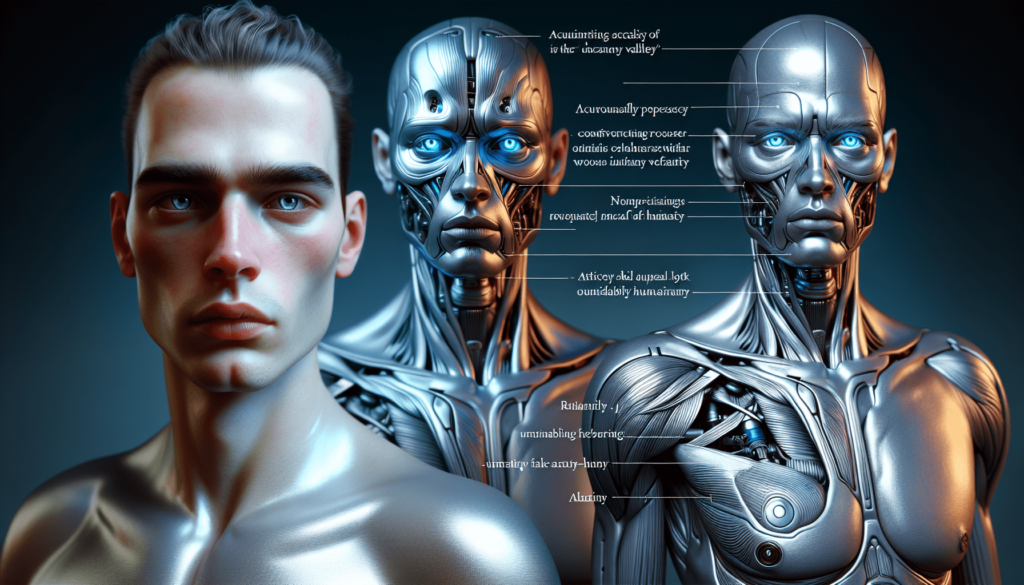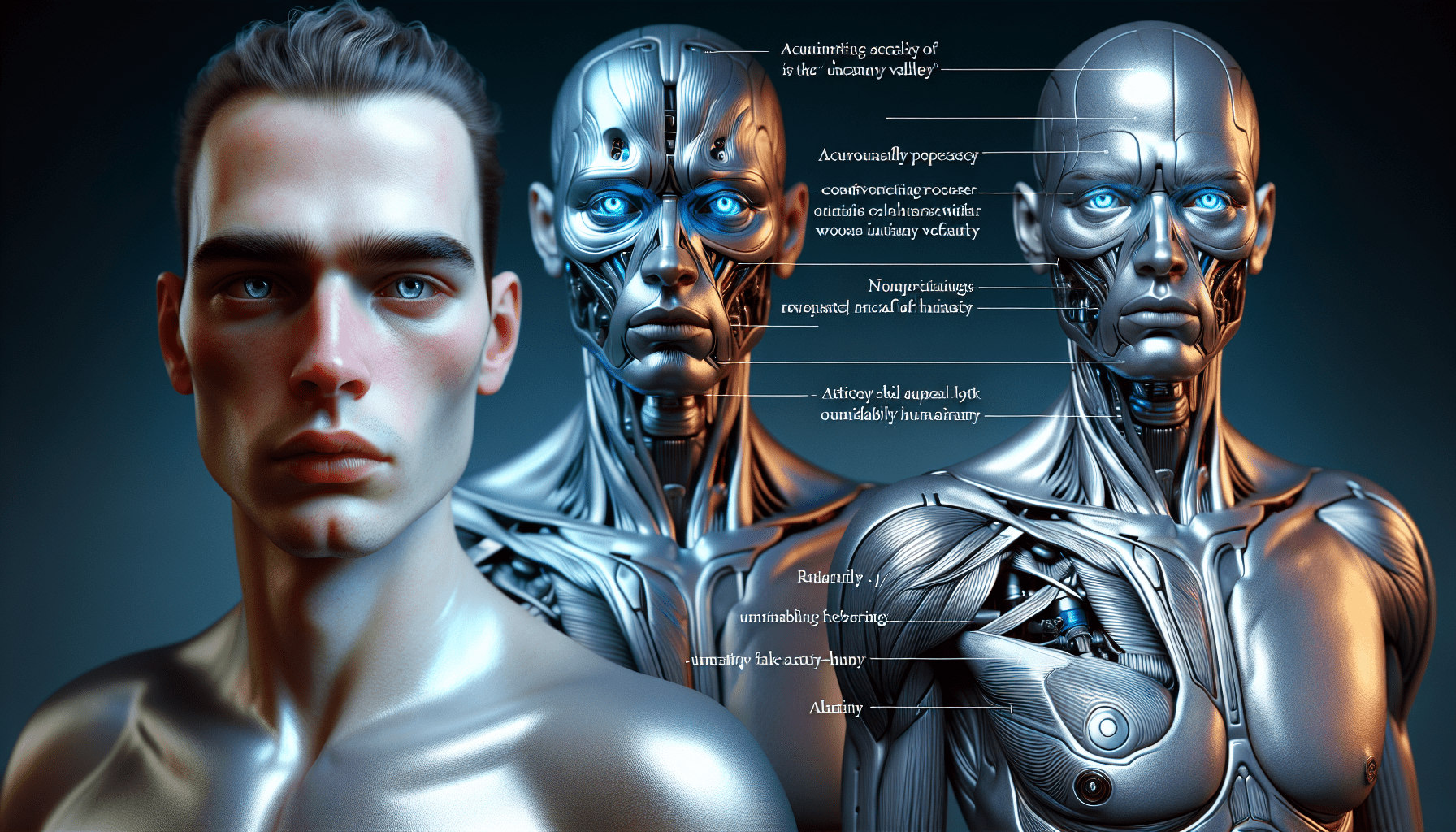Have you ever noticed that there’s something slightly off-putting about a humanoid robot or a computer-generated character? That feeling of unease and discomfort is what experts call the “uncanny valley.” In this article, we will explore the concept of the uncanny valley, its origins, and why it continues to fascinate and intrigue both scientists and artists alike. So, buckle up and get ready to delve into the fascinating world of the uncanny valley.
Definition of the Uncanny Valley
The term “uncanny valley” refers to a psychological phenomenon that occurs when a human-like object or replica is almost, but not quite, convincingly realistic. In this state, the object invokes a sense of eeriness, unease, or discomfort in the observer. The concept was first introduced by Japanese roboticist Masahiro Mori in 1970, and it has since become a widely recognized and researched phenomenon in various fields, including psychology, robotics, and design.
The Uncanny Valley in Psychology
The concept of the uncanny valley is deeply rooted in psychological theory. According to Mori’s hypothesis, when we encounter an object that closely resembles a human but falls short of complete realism, our brain processes it as a strange and unsettling sight. This triggers a conflict between the observer’s expectation of familiarity and the object’s slightly off-putting features. This psychological response can result in negative affective reactions, such as repulsion or fear, as well as cognitive dissonance.
Understanding the human tendency to react negatively to objects in the uncanny valley is crucial. Studies have shown that this aversion is not limited to highly synthetic human-like robots but also extends to less realistic representations, such as computer-generated characters in films and even certain dolls and mannequins. This suggests that the human brain has an inherent sensitivity to deviations from expected human likeness.
The Uncanny Valley and Robotics
The concept of the uncanny valley has significant implications for the design and development of humanoid robots. As robotics technology advances, attempts to create robots that closely resemble humans face numerous challenges. Designers often strive to achieve a balance between realism and avoiding the uncanny valley.
Creating a robot that falls within the uncanny valley can evoke strong negative emotions and hinder successful human-robot interaction. This is particularly relevant in scenarios where robots are intended to serve as companions, caregivers, or assistants. If the robot’s appearance and behavior trigger discomfort or unease, users may have difficulty establishing trust and forming meaningful connections with the machines.

Examples of the Uncanny Valley
The uncanny valley can be observed in various aspects of popular culture, particularly in the portrayal of zombies in movies. Zombies exhibit human-like features and characteristics but lack the warmth and lifelike presence of actual humans. This creates a feeling of unease and repulsion among viewers, contributing to the horror genre’s effectiveness.
Another example can be seen in the uncanny feeling that certain dolls and mannequins can elicit. These objects closely resemble humans but lack the warmth, responsiveness, and natural movement associated with living beings. As a result, some individuals find them unsettling, leading to feelings of discomfort or fear.
Computer-generated characters in films, such as those created through CGI, can also elicit an uncanny valley effect. While advancements in technology have made these characters increasingly realistic, there is still often a noticeable discrepancy between their appearance and human features, which can provoke feelings of unease or strangeness in viewers.
Factors Affecting the Uncanny Valley
Several factors contribute to the placement and intensity of the uncanny valley effect. The realism and accuracy of human-like features play a significant role. If an object or robot has an almost perfect resemblance to a human, but subtle differences are detectable, it can trigger a stronger response from observers.
Smoothness of movements is also a crucial factor. Humans naturally possess fluid and coordinated movements, which lend to their lifelike presence. Objects or robots that mimic human motion but fall slightly short can create a jarring effect, exacerbating the sense of unease.
The depth of eye contact is another critical aspect. Eye contact is an important cue in human communication, and slight deviations in a robot’s gaze can feel unnatural. Lack of accurate eye contact can further contribute to the uncanny valley and make interactions with humanoid robots feel unsettling.
Lastly, proximity to human appearance is significant. Research has found that as the resemblance to an actual human increases, the magnitude of the uncanny valley effect intensifies. This implies that objects or robots that closely resemble humans but do not achieve perfect realism are more likely to generate discomfort and negative reactions.
Cognitive Dissonance in the Uncanny Valley
The uncanny valley triggers cognitive dissonance – a state of psychological discomfort caused by holding contradictory beliefs or experiencing conflicting responses. When confronted with a human-like object that elicits negative emotions, people experience a discrepancy between their expectation of familiarity and the discomfort arising from the object’s imperfections.
To resolve this dissonance, individuals may employ various strategies. One common approach is to distance oneself from the object, avoiding further interactions or contact. This strategy allows individuals to reduce their discomfort by minimizing exposure to the source of cognitive dissonance.
Another strategy involves cognitive reappraisal or rationalization. Individuals may try to convince themselves that the unsettling features or behaviors of a human-like object are inconsequential or insignificant. By downplaying the significance of the discrepancies, individuals attempt to alleviate their negative emotions and lessen the impact of the uncanny valley effect.
Evolutionary Explanations for the Uncanny Valley
An evolutionary perspective can shed light on the uncanny valley phenomenon. Humans possess an innate ability to recognize and interpret human faces, allowing for crucial social interactions and communication. This ability likely evolved as a survival advantage in order to identify and connect with conspecifics.
The uncanny valley may arise from the brain’s tendency to generalize these facial recognition abilities towards objects that possess some human-like features. This over-generalization can lead to mistaking artificial objects, such as robots or computer-generated characters, for real humans.
Mistaking non-human objects for genuine humans could have survival implications. Humans are biologically inclined to be cautious and wary of unknown individuals or unfamiliar faces. The uncanny valley effect may serve as a way to signal potential threats or dangers, prompting individuals to maintain distance or approach with caution.
Cultural Differences and the Uncanny Valley
Cultural factors play a significant role in shaping interpretations of the uncanny valley. Varying cultural backgrounds and experiences can influence individuals’ perceptions of humanoid robots and their comfort levels with human-like replicas.
Different cultures may have diverse interpretations of what is considered familiar or acceptable in terms of appearance and behavior, impacting the uncanny valley response. Research has shown that individuals from cultures with a stronger tradition of animism, where inanimate objects are believed to possess spirits or lifelike characteristics, are more accepting and less prone to discomfort when interacting with humanoid robots.
Moreover, cultural norms and expectations regarding robots’ roles and capabilities can also influence perceptions and acceptance levels. For instance, societies that embrace technology and automation may exhibit higher acceptance of humanoid robots and show less sensitivity to the uncanny valley effect.
Overcoming the Uncanny Valley
Designers and researchers have explored various strategies to overcome the uncanny valley and create more acceptable human-like objects or robots. Improvements in robot design involve refining the appearance and movement of robots, ensuring that they closely align with the expectations and familiarity of the human observer.
Enhancing facial expressions and gestures is another crucial aspect. By creating robots that can display a wide range of emotions and respond naturally to social cues, designers aim to bridge the gap between the artificial and the human, reducing the sense of unease and discomfort.
Another approach is to explore non-humanoid designs. Rather than striving for human-like replicas, some designers prefer to create abstract or animal-inspired robotics. This avoids the uncanny valley effect altogether and allows for a different form of interaction that does not rely on human likeness.
Future Implications of the Uncanny Valley
The uncanny valley has far-reaching implications for industries such as entertainment and healthcare. The entertainment industry heavily relies on realistic computer-generated characters, and reducing the uncanny valley effect can enhance audience engagement and immersion.
In healthcare, humanoid robots are increasingly being developed to assist with tasks such as patient care and therapy. Reducing the uncanny valley effect in these healthcare settings is crucial to promote trust and establish a positive patient-robot relationship.
Ethically, the uncanny valley raises questions about the boundaries of human-like replication and the potential consequences of creating robots that are almost indistinguishable from humans. Societal acceptance and adoption of humanoid robots will also play a significant role in shaping the future applications and implications of the uncanny valley.
In conclusion, the uncanny valley is a complex psychological phenomenon that influences our perception and emotional response to human-like objects or robots. Understanding the factors that contribute to the uncanny valley effect allows for improved design and better human-robot interaction. As technology advances, bridging the uncanny valley becomes essential in order to create seamless and meaningful connections between humans and machines.
